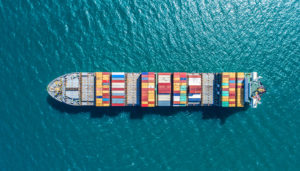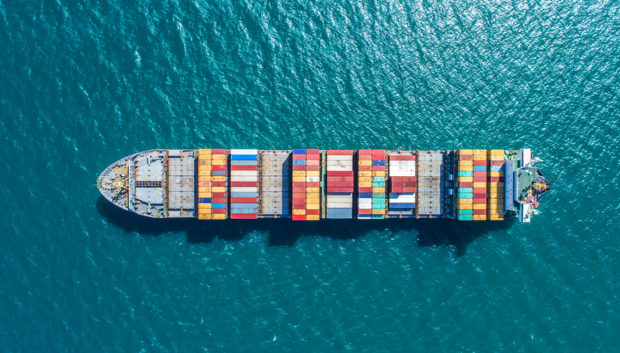Large shipping losses declined by more than 50% in 2018 from the previous year – their lowest level this century, according to Allianz Global Corporate & Specialty SE’s (AGCS) Safety & Shipping Review 2019.

In 2018, 46 large ships were lost across the globe, down from 98 in the previous year, the report said, noting that this significant decrease was driven by a decline of losses in the global hotspot, South East Asia, as well as weather-related losses halved during a quieter year for hurricanes and typhoons.
AGCS’ annual study analyzes reported shipping losses over 100 gross tons (GT).
Despite the dramatic and encouraging reduction in total losses, the report said, the number of overall reported shipping incidents showed only marginal improvement, declining by less than 1% to 2,698 in 2018.
The report noted that machinery damage is the major cause for such shipping incidents, accounting for more than one-third of the 26,000-plus incidents over the past decade – twice as many as the next highest cause, collision.
Machinery damage is one of the most expensive causes of marine insurance claims, accounting for more than US$1 billion over the past five years, said AGCS, quoting an analysis of 230,961 marine insurance industry claims featuring AGCS and other insurers between July 2013 and July 2018.
“Today’s record low total loss activity is certainly influenced by fortunate circumstances in 2018, but it also underlines the culmination of the long-term improvement of safety in the global shipping industry,” said Baptiste Ossena, global product leader, Hull & Marine Liabilities, AGCS.
“Improved ship design, technology, tighter regulation and more robust safety management systems on vessels have also helped to prevent breakdowns and accidents from turning into major losses,” Ossena added. “However, the lack of an overall fall in shipping incidents, heightened political risks to vessel security, complying with 2020 emissions rules and the growing number of fires on board bring challenges.”
Accident Hotspots
The South China, Indochina, Indonesia and Philippines maritime region remains the top loss location, with one in four – or 12 losses – occurring there, said AGCS. The good news, however, is that this is significantly down from 29 losses reported a year earlier.
The East Mediterranean and Black Sea – with six losses – and the British Isles – with four losses – rank second and third.
Despite signs of improvement, Asia will remain a hotspot for marine claims due to its high level of trade, busy shipping routes and older fleets, although newer infrastructure, better port operations and more up-to-date navigation tools will help to address challenges, the report confirmed.
Common Causes of Loss
The loss of 15 cargo ships accounted for one-third of vessels lost around the world in the past year. The most common cause of ship losses continues to be foundering (sinking), which has accounted for over half (551) of the 1,036 vessels lost over the past decade. In 2018, 30 cases were reported.
Fires continue to generate large losses with 174 reported incidents in 2018 – a trend that has continued into 2019 with a number of recent incidents on container ships and three significant events on car carriers, the report said.
The report said that mis-declared cargo, including incorrect labeling/packaging of dangerous goods is believed to be the cause of a number of fires at sea.
As on-board fire-fighting capability can be limited, if considerable outside assistance is required, significant damage can occur to the ship before this happens, which greatly increases the size of salvage claims, the report said.
The report went on to say that damaged goods are the most frequent generator of marine insurance claims, accounting for one in five over the five year period between July 2013 and July 2018. (These statistics are once again provided by an analysis of marine insurance industry claims, said AGCS).
Emissions Regulations
Regulation limiting sulfur oxide emissions will go into effect in January 2020, creating wide-ranging implications for cost, compliance and crew, the AGCS report said. (Editor’s note: From January 2020, regulations formed by the International Maritime Organization, or IMO, will ban ships from using fuels with a sulfur content above 0.5%, compared to current levels of 3.5%. Only ships fitted with sulfur-cleaning “scrubbers” will be permitted to burn high-sulfur fuel.)
Large ports across the globe are even considering deploying so called “sniffer drones” to detect environmental rule-breakers – ships not using more expensive low-sulfur fuels may face significant penalties, the report continued.
“It is important shipping plays its part in a more sustainable environment. However, despite the fast approaching deadline, there is still a lack of international standards and concern over the availability and compatibility of low-sulfur fuel,” explained Captain Rahul Khanna, global head of Marine Risk Consulting, AGCS. “Insurers are concerned about a potential increase in machinery breakdown claims with the introduction of low sulfur fuels if the transition is not well-managed. There is also potential for disruptions and delays to voyages if there is a lack of compliant, compatible fuel in port.”
Other topics discussed by the AGCS Safety and Shipping Review include:
- Growing number of incidents on larger vessels. Container-carrying capacity has almost doubled over a decade and a worst-case loss scenario could cost as much as US$4 billion in the future.
- Over-reliance on technology. Safety-enhancing technology in shipping has been positive for safety and claims, yet accidents continue to happen due to over-reliance on the technology. The report said this is why crews and officers must understand its shortcomings and limitations. The report pointed to the grounding of and total loss of the Maltese registered 2,194 TEU capacity containership Kea Trader in the Pacific Ocean on July 12, 2017, which was caused by a series of human errors, including an over-reliance on the vessel’s electronic navigation.
- Autonomous shipping makes progress. While scientists and engineers continue to work to develop autonomous ships in various countries and companies, the report said, this technology is not a panacea if the root cause of incidents and losses is not addressed, such as mis-declared cargo in the case of fires in ultra-large containerships (ULCS).
- Evolving security threats. Political risk has heightened around the globe, posing an increasing threat to shipping security, trade and supply chains through conflicts, territorial disputes, cyber attacks, sanctions, piracy and even sabotage. Indeed, piracy incidents increased over the past year, with Nigeria replacing Indonesia as the top global hotspot. In addition, the growing number of migrants at sea and an increase in stowaways on commercial vessels also has serious consequences for shipowners, leading to delays, diversions and pressure on crew.
The AGCS Safety & Shipping Review can be downloaded from the company’s website.
Source: Allianz Global Corporate & Specialty
*This story ran previously in our sister publication Insurance Journal.





















 Executives on the Move at Liberty Mutual, Cowbell, W. R. Berkley
Executives on the Move at Liberty Mutual, Cowbell, W. R. Berkley  Five AI Trends Reshaping Insurance in 2026
Five AI Trends Reshaping Insurance in 2026  NOAA Announces Latest AI-Driven Global Weather Models
NOAA Announces Latest AI-Driven Global Weather Models  What to Expect in 2026: U.S. P/C Results More Like 2024
What to Expect in 2026: U.S. P/C Results More Like 2024 










